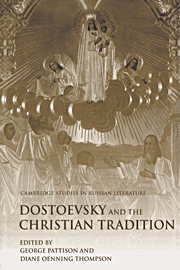Book contents
- Frontmatter
- Contents
- Notes on contributors
- Acknowledgments
- Notes on conventions and abbreviations
- Introduction: Reading Dostoevsky religiously
- PART I DOSTOEVSKY AND THE PRACTICE OF ORTHODOXY
- PART II DOSTOEVSKY AND CHRISTIAN THEOLOGY
- 5 Dostoevsky in the prism of the orthodox semiosphere
- 6 The categories of Law and Grace in Dostoevsky's poetics
- 7 The Brothers Karamazov as trinitarian theology
- 8 Reading and incarnation in Dostoevsky
- PART III READING DOSTOEVSKY RELIGIOUSLY: CASE STUDIES
- Bibliography
- Index
- CAMBRIDGE STUDIES IN RUSSIAN LITERATURE
8 - Reading and incarnation in Dostoevsky
Published online by Cambridge University Press: 02 December 2009
- Frontmatter
- Contents
- Notes on contributors
- Acknowledgments
- Notes on conventions and abbreviations
- Introduction: Reading Dostoevsky religiously
- PART I DOSTOEVSKY AND THE PRACTICE OF ORTHODOXY
- PART II DOSTOEVSKY AND CHRISTIAN THEOLOGY
- 5 Dostoevsky in the prism of the orthodox semiosphere
- 6 The categories of Law and Grace in Dostoevsky's poetics
- 7 The Brothers Karamazov as trinitarian theology
- 8 Reading and incarnation in Dostoevsky
- PART III READING DOSTOEVSKY RELIGIOUSLY: CASE STUDIES
- Bibliography
- Index
- CAMBRIDGE STUDIES IN RUSSIAN LITERATURE
Summary
‘Only what on earth do I want here? Yes, to read!’
(Raskolnikov in Crime and Punishment)Why do Dostoevsky's characters read? Over two decades ago, Ralph Matlaw called attention to Dmitryj Tschizewskij's ‘seminal’ 1929 essay on the influence of Schiller in The Brothers Karamazov: in his words, it emphasised ‘Dostoevsky's extraordinary concern with the use of literature, the possibilities of characterization and deepening of portraits by citation of other literary works, a technical innovation of Dostoevsky's which has not yet been sufficiently investigated.’ Within the past twenty years, valuable investigations have been made of this area, not the least of which are Victor Terras's commentary on The Brothers Karamazov, which documents scores of literary allusions, quotations, and paraphrases; Nina Perlina's analysis of the aesthetic function of quotation in that same novel; and a convenient compilation of Gospel-related excerpts from Dostoevsky's fiction, issued by the Hutterian Brethren. Nonetheless, a heightened awareness of the myriad citations in Dostoevsky's fiction will not alone lead to a full comprehension of his narrative employment of literature, hagiography and the Bible, or the role such citations play in his portrayal of characters. There is, of course, the formal question of how such citations fit into his broader poetics of polyphony, dialogism and carnival, as these hallmarks of his art were so notably fleshed out by Mikhail Bakhtin. An answer could probably be drawn from Bakhtin's discussion of Dostoevsky's creative renewal of the ancient menippean genre. With its characteristically wide use of various inserted genres (novellas, letters, speeches, newspaper articles and so forth), and its tendency to mix prose and verse, the menippea would seem naturally conducive to incorporating literary, biblical and other citations.
- Type
- Chapter
- Information
- Dostoevsky and the Christian Tradition , pp. 156 - 170Publisher: Cambridge University PressPrint publication year: 2001



